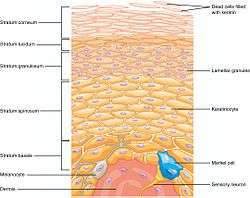Merkel cell
| Merkel cell | |
|---|---|
 Merkel cells (shown in blue) are located in the basal epidermal layer of the skin. | |
| Identifiers | |
| NeuroLex ID | Merckel disc cell |
Merkel cells, also known as Merkel-Ranvier cells or tactile epithelial cells, are oval-shaped mechanoreceptors essential for light touch sensation and found in the skin of vertebrates. They are abundant in highly sensitive skin like that of the fingertips in humans, and make synaptic contacts with somatosensory afferent nerve fibers.[1] Although uncommon, these cells may become malignant and form a Merkel cell carcinoma—an aggressive and difficult to treat skin cancer.[2]
Although it has been reported that Merkel cells are derived from neural crest cells,[3] more recent experiments in mammals have indicated that they are in fact epithelial in origin.[4]
Location

Merkel cells are found in the skin and some parts of the mucosa of all vertebrates. In mammalian skin, they are clear cells found in the stratum basale (at the bottom of sweat duct ridges) of the epidermis approximately 10 µm in diameter. They also occur in epidermal invaginations of the plantar foot surface called rete ridges.[5] Most often, they are associated with sensory nerve endings, when they are known as Merkel nerve endings (also called a Merkel cell-neurite complex). They are associated with slowly adapting (SA1) somatosensory nerve fibers.
Function
Friedrich Sigmund Merkel referred to these cells as Tastzellen or "touch cells" but this proposed function has been controversial as it has been hard to prove. However, genetic knockout mice have recently shown that Merkel cells are essential for the specialized coding by which afferent nerves resolve fine spatial details.[6] Merkel cells are sometimes considered APUD cells (an older definition. More commonly classified as a part of dispersed neuroendocrine system) because they contain dense core granules, and thus may also have a neuroendocrine function.
Developmental origin
The origin of Merkel cells has been debated for over 20 years. Evidence from skin graft experiments in birds implies that they are neural crest derived, but experiments in mammals now demonstrate an epidermal origin.[7][8]
See also
- Merkel nerve ending
- Merkel cell carcinoma
- List of keratins expressed in the human integumentary system
References
- ↑ Mescher, Anthony L (2016). Junqueira's Basic Histology. McGraw-Hill Education. ISBN 978-0-07-184270-9.
- ↑ Munde, Prashant (17 Jan 2014). "Pathophysiology of merkel cell". Journal of Oral and Maxillofacial Pathology. 17 (3): 408–412. doi:10.4103/0973-029x.125208.
- ↑ K. I. Baumann; Zdenek Halata; I. Moll (2003). The Merkel cell: structure-development-function- cancerogenesis. Springer. pp. 99–. ISBN 978-3-540-00374-8. Retrieved 2 May 2010.
- ↑ Morrison, Kristin; George R. Miesegaes; Ellen A. Lumpkin; Stephen M. Maricich (2009). "Mammalian Merkel cells are descended from the epidermal lineage.". Developmental Biology. 336. doi:10.1016/j.ydbio.2009.09.032. PMC 2783667
 . PMID 19782676.
. PMID 19782676. - ↑ Halata, Z; Grim, M; Bauman, KI (2003). "Friedrich Sigmund Merkel and his "Merkel cell", morphology, development, and physiology: review and new results". The Anatomical Record Part A: Discoveries in Molecular, Cellular, and Evolutionary Biology. 1) (271): 225–39. doi:10.1002/ar.a.10029. PMID 12552639.
- ↑ Maricich SM; Wellnitz SA; Nelson AM; Lesniak DR; Gerling GJ; Lumpkin EA; Zoghbi HY. (2009). "Merkel Cells are Essential for Light Touch Responses". Science. 324 (5934): 1580–82. doi:10.1126/science.1172890. PMC 2743005
 . PMID 19541997.
. PMID 19541997. - ↑ Morrison KM; Miesegaes GR; Lumpkin EA; Maricich SM. (September 25, 2009). "Mammalian Merkel cells are descended from the epidermal lineage". Dev Biol. 336 (1): 76–83. doi:10.1016/j.ydbio.2009.09.032. PMC 2783667
 . PMID 19782676.
. PMID 19782676. - ↑ Van Keymeulen A; Mascre G; Youseff KK; Harel I; Michaux C; De Geest N; Szpalski C; Achouri Y; Bloch W; Hassan BA; Blanpain C. (2009). "Epidermal progenitors give rise to Merkel cells during embryonic development and adult homeostasis". J Cell Biol. 1 (187): 91–100. doi:10.1083/jcb.200907080. PMC 2762088
 . PMID 19786578.
. PMID 19786578.
External links
- MeSH A08.800.550.700.500.425
- NIF Search - Merckel Disc Cell via the Neuroscience Information Framework